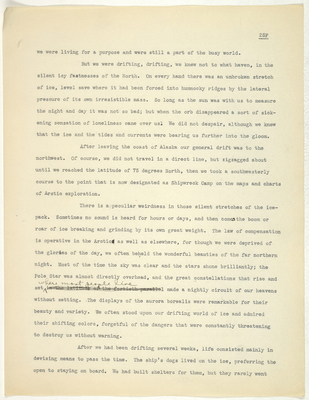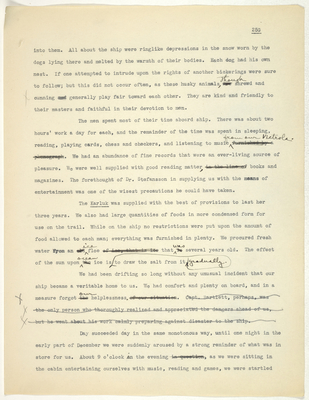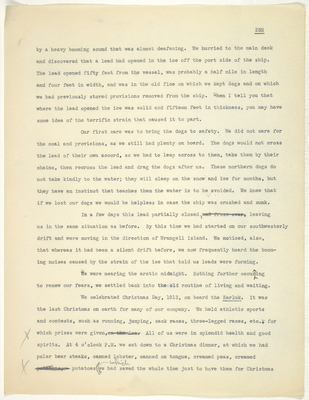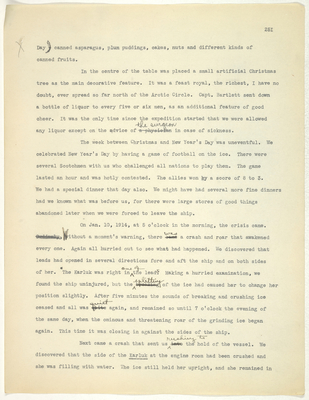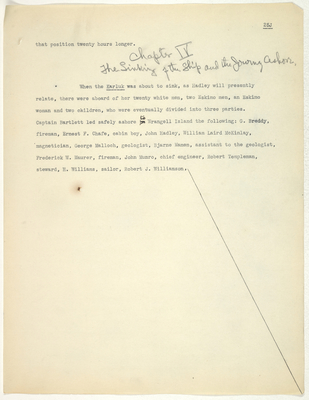Pages
stefansson-wrangel-09-26-001-036
25F
we were living for a purpose and were still a part of the busy world.
But we were drifting, drifting, we knew not to what haven, in the silent icy fastnesses of the North. On every hand there was an unbroken stretch of ice, level save where it had been forced into hummocky ridges by the lateral pressure of its own irresistible mass. So long as the sun was with us to measure the night and day it was not so bad; but when the orb disappeared a sort of sickening sensation of loneliness came over us. We did not despair, although we knew that the ice and the tides and currents were bearing us further into the gloom.
After leaving the coast of Alaska our general drift was to the northwest. Of course, we did not travel in a direct line, but zigzagged about until we reached the latitude of 75 degrees North, then we took a southwesterly course to the point that is now designated as Shipwreck Camp on the maps and charts of Arctic exploration.
There is a peculiar weirdness in those silent stretches of the icepack. Sometimes no sound is heard for hours or days, and then comes the boom or roar of ice breaking and grinding by its own great weight. The law of compensation is operative in the Arctic as well as elsewhere, for though we were deprived of the glories of the day, we often beheld the wonderful beauties of the far northern night. Most of the time the sky was clear and the stars shone brilliantly; the Pole Star was almost directly overhead, and the great constellations that rise and set where most people live made a nightly circuit of our heavens without setting. The displays of the aurora borealis were remarkable for their beauty and variety. We often stood upon our drifting world of ice and admired their shifting colors, forgetful of the dangers that were constantly threatening to destroy us without warning.
After we had been drifting several weeks, life consisted mainly in devising means to pass the time. The ship's dogs lived on the ice, preferring the open to staying on board. We had built shelters for them, but they rarely went
stefansson-wrangel-09-26-001-037
into them. All about the ship were ringlike depressions in the snow worn by the dogs lying there and melted by the warmth of their bodies. Each dog had his own nest. If one attempted to intrude upon the rights of another bickerings were sure to follow; but this did not occur often, as these husky animal , though shrewd and cunning generally play fair toward each other. They are kind and friendly to their masters and faithful in their devotion to men.
The men spent most of their time aboard ship. There was about two hours' work a day for each, and the remainder of the time was spent in sleeping, reading, playing cards, chess and checkers, and listening to music furnished by a from our phongraph Victrola. We had an abundance of fine records that were an ever-living source of pleasure. We were well supplied with good reading matter, in thw linw" gf books and magazines. The forethought of Dr. Stefansson in supplying us with the means of entertainment was one of the wisest precautions he could have taken.
The Karlulc was supplied with the best of provisions to last her three years. We also had large quantities of foods in more condensed form for use on the trail. While on the ship no restrictions were put upon the amount of food allowed to each man; everything was furnished in plenty. We procured fresh water from an old ice floe of ice, that is ice that was several years old. The effect of the sun upon ocean the ice is gradually to draw the salt from it.
We had been drifting so long without any unusual incident that our ship became a veritable home to us. We had comfort and plenty on board, and in a measure forgot the our helplessness. of our situation. Capt. Bartlett, perhaps was the only person who- thoroughly realized and appreciated the dangers ahead of us, but he went about his work calmly preparing against disaster to the ship.
Day succeeded day in the same monotonous way, until one night in the early part of December we were suddenly aroused by a strong reminder of what was in store for us. About 9 o'clock ion the evening in question, as we were sitting in the cabin entertaining ourselves with music, reading and games, we were startled
stefansson-wrangel-09-26-001-038
25H
by a heavy booming sound that was almost deafening. We hurried to the main deck and discovered that a lead had opened in the ice off the port side of the ship. The lead opened fifty feet from the vessel, was probably a half mile in length and four feet in width, and was in the old floe on which we kept dogs and on which we had previously stored provisions removed from the ship. Wen I tell you that where the lead opened the ice was solid and fifteen feet in thickness, you may have some idea of the terrific strain that caused it to part.
Our first care was to bring the dogs to safety. We did not care for the coal and provisions, as we still had plenty on board. The dogs would not cross the lead of their own accord, so we had to leap across to them, take them by their chains, then recross the lead and drag the dogs after us. These northern dogs do not take kindly to the water; they will sleep on the snow and ice for months, but they have an instinct that teaches them the water is to be avoided. We knew that if we lost our dogs we would be helpless in case the ship was crushed and sunk.
In a few days this lead partially closed, and froze over, leaving us in the same situation as before. By this time we had started on our southwesterly drift and were moving in the direction of Wrangell Island. We noticed, also, that whereas it had been a silent drift before, we now frequently heard the booming noises caused by the strain of the ice that told us leads were forming.
We were nearing the arctic midnight. Nothing further occuring to renew our fears, we settled back into theebid routine of living and waiting.
We celebrated Christmas Day, 1913, on board the Karluk. It was the last Christmas on earth for many of our company. Wr held athletic sports and contests, such as running, jumping, sack races, three-legged races, etc., for which prizes were given, on the ice. All of us were in splendid health and good spirits. At 4 o'clock P.M. we sat down to a Christmas dinner, at which we had polar bear steaks, canned lobster, canned ox tongue, creamed peas, creamed [yWwfltf ]potatoes which we had saved the whole time just to have them for Christmas
stefansson-wrangel-09-26-001-039
25I
Day) canned asparagus, plum puddings, cakes, nuts and different kinds of canned fruits.
In the centre of the table was placed a small artificial Christmas tree as the main decorative feature. It was a feast royal, the richest, I have no doubt, ever spread so far north of the Arctic Circle. Capt. Bartlett sent down a bottle of liquor to every five or six men, as an additional feature of good cheer. It was the only time since the expedition started that we were allowed any liquor except on the advice of a physician the surgeon in case of sickness.
The week between Christmas and New Year's Day was uneventful. We celebrated New Year's Day by having a game of football on the ice. There were several Scotchmen with us who challenged all nations to play them. The game lasted an hour and was hotly contested. The allies won a score of 8 to 3. We had a special dinner that day also. We might have had several more fine dinners had we known what was before us, for there were large stores of good things abandoned later when we were forced to leave the ship.
On Jan. 10, 1914, at 5 o'clock in the morning, the crisis came. Suddenly Without a moment's warning, there came was a crash and roar that awakened every one. Again all hurried out to see what had happened. We discovered that leads had opened in several directions fore and aft the ship and on both sides of her. The Karluk was right in one of leads. Making a hurried examination, we found the ship uninjured, but the breaking splitting of the ice had caused her to change her position slightly. After five minutes the sounds of breaking and crushing ice ceased and all was quite quietagain, and remained so until 7 o’clock the evening of the same day, when the ominous and threatening roar of the grinding ice began again. This time it was closing in against the sides of the ship.
Next came a crash that sent us into rushing to the hold of the vessel. We discovered that the side of the Karluk at the engine room had been crushed and she was filling with water. The ice still held her upright, and she remained in
stefansson-wrangel-09-26-001-040
25J
that position twenty hours longer.
Chapter IV The Sinking of the Ship and the Journey Ashor
When the Karluk was about to sink, as Hadley will presently relate, there were aboard of her twenty white men, two Eskimo men, an Eskimo woman and two children, who were eventually divided into three parties. Captain Bartlett led safely ashore in to Wrangell Island the following: G. Breddy, fireman, Ernest F. Chafe, cabin boy, John Hadley, William Laird McKinlay, magnetician, George Malloch, geologist, Bjarne Mamen, assistant to the geologist, Frederick W. Maurer, fireman, John Munro, chief engineer, Robert Templeman, steward, H. Williams, sailor, Robert J. Williamson,
